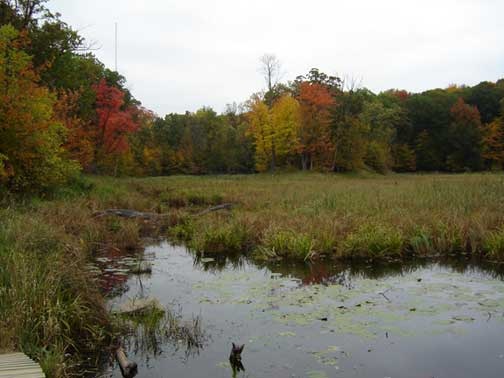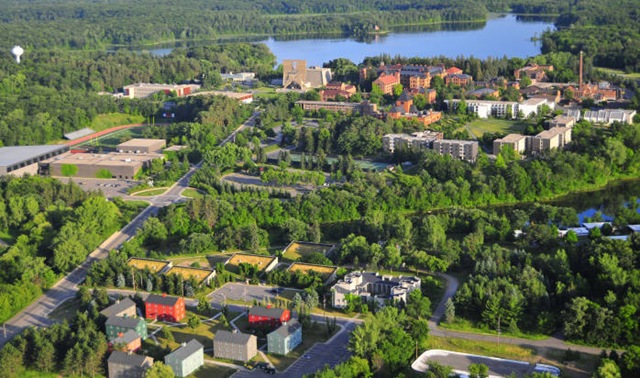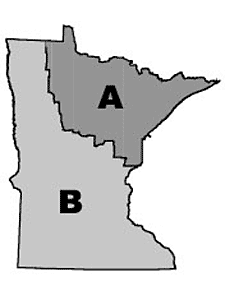Gary
Pflueger had no time to talk- he was too busy, juggling his responsibilities
working on the grounds at Saint John’s University and running his small farm in
the rocky slopes and wet valleys that lie between Avon and Saint Joseph, Minnesota. When I
caught up with him, to ask his opinion on the local Avon Hills Initiative, he
paused only for a few seconds.
“Well”, said, “I got to tell you, they’re
certainly not my favorite organization”
A
strong opinion, by Central Minnesota standards. It was the first, though not
the last, of many uncharacteristically strong opinions I would hear that day. But
what was it that could invoke such feelings of passion from a stoic resident of
‘Lake Wobegon’ country? It is a story of changes in a community, and of the
relationship between residents, a university, and local
government.
As with so many things in rural America,
though, it all starts with the land.
The
Avon Hills rise above the farms of eastern Stearns County, 80 square miles of
rolling slopes, eskers, and moraines dotted with lakes and marshes, carved by
the retreating glaciers of the last ice age. What sets the region apart from
the surrounding fields, however, is the forest. The hills, which stretch over
the Avon, Collegeville, Saint Joseph, and Saint Wendel townships, contain the
highest concentration of the native plant communities in the county, with abundant
oak, maple, and basswood forest, tamarack and mixed-hardwood swamps, and
wetland meadows.
 |
| The Hills contain the largest intact forest in central Minnesota |
These
forests were once common throughout central Minnesota, but largely disappeared
with the arrival of white settlement, giving way to farm fields. The Avon Hills
were preserved by their topography. The rolling slopes, soil thick with stones,
and marshes were not hospitable to large expanses of corn. A handful of
families carved out small patches of farmland and grazed livestock, but outside
of the town of Avon itself and the grounds of Saint John’s Abbey and
University, the hills were largely spared the axe and the plow, leaving the
forest intact.
That
forest supports a diversity of animal life. In addition to the deer, coyotes, beavers,
and other common animals, the region harbors several rare species, including
the cerulean warbler, red-shouldered hawk, least darter, Blanding's turtle, and
American ginseng. It has been categorized as ecologically significant by both
the Minnesota DNR and the Nature Conservancy's Eco-Regional Plan. The Hills,
the largest intact block of kettle and moraine forest between the Twin Cities
and Morrison County, are also a rest stop for migrating bird populations
through Minnesota and habitat for wood ducks and other water fowl as well as
songbirds, for which it is recognized as an Important Bird Area by the
Minnesota DNR.
 |
| Family farms have declined in recent decades |
Some
residents, however, worry that the Hills are at risk. The forest has come under
increasing pressure from development in the last four decades. The north end of
the hills were intersected by I-94 in the 1970s, at the same time that an
emerging middle class drove demand for scenic lakeshore and rural land. The
demographics of the community have shifted from the large, long-standing
holdings of family farms towards the newer, smaller plots that host the homes
of professionals and small business owners.
“Collegeville
does not support a lot of full time farmers anymore.”, said one
resident of the township who preferred not to be named “We’ve become a recreational area, with the lakes.
There’s a lot of development pressure, and the ecosystem is pretty fragile.”
The
development pressure does not come only from the demand for scenic property. The
nearby urban area is expanding- in the 2000s, Saint Joseph was the second
fastest growing city in Minnesota, beaten only by nearby Sartell. The population of
Stearns County is expected to increase up to 33% between 2000 and 2030,
according to the Stearns County Comprehensive Plan. With such growth,
conservation advocates worry that the Hills may see housing developments
replace woodland.
 |
| Many Minnesotans aspire to own a home by a lake |
It
was in the midst of these concerns that the Avon Hills Initiative formed in
2003. The group, which consists of local residents as well as members of the
Saint John’s University community, states that it aims to “Preserve the rural
character of our community, protect the quality of our natural areas, and
maintain economic productivity in our communities while respecting individual
landowner rights”.
To
this end, the Initiative has sought to establish a series of six to ten
conservation easements throughout the Avon Hills. These easements, funded in
part by a grant from the Minnesota Environment and Natural Resources Trust Fund,
allow landowners to retain ownership of the land, but restricts development of
the land or use that is not consistent with the protection of the natural
features as specified in the easement. The easement remains even if ownership
of the land transfers. The first of these easements was completed in 2009, on
34 acres along Watab Creek belonging to Robert and Bonnie Thomsen.
Kate
Bobeldyk, the Chair of the Executive Committee of the Initiative, says that the
organization is now in the second round of seeking easements to both preserve
and restore local land.
“Most
people love the hills, water, wildlife, and open spaces and want to preserve
it.” said Bobeldyk “Sometimes, they don't know how, so our goal is to help them
to do it- to offer them guidelines and incentives. We're not in the business of
trying to regulate or police what's going on our here. We’re in the business of
trying to educate, and pull together the right people, whether it be the county
or the township.”
The
Initiative has helped Stearns County and local townships to design a
Conservation Overlay district for the Avon Hills, Bobeldyk said. This special
district, which overlaps the four townships on which the hills rest, limits the
number of building sites per acreage, requiring a certain amount of land to
remain undeveloped. It also allows cluster development, which allows several
houses to be built in close proximity if nearby land is set off as open space.
“I'm
not sure if I agree with all of the zoning ideas- like cluster housing.” said
Ben Carlson, an SJU senior and local resident. “I think the AHI should focus
more on the agricultural aspect and on the value of woodlands.”
 |
| Wetlands at the Saint John's Arboretum |
Stearns
County was awarded the 2010 County Conservation Award for its establishment of
the overlay district.
The
Initiative also organizes the Avon Hills Conference, a day-long collection of
seminars and discussions held annually at Saint John’s University, exploring
topics that range from nature photography to green construction. John O’Reilly
is an organizer of the event, which will next be held on February 2, 2013.
“The
executive committee initially started the Avon Hills Conference as a way for
local landowners to learn more about conservation and easements”, said
O’Reilly, “But it quickly evolved into an event for all Avon Hills residents to
have a day of learning and community.”
Ben Carlson praised the conference.
“I
think it’s a great chance for Saint John’s to interact with the community.”, he
said. “There are the old farmers, and the other people who live here because of
the lakes or the university, and it’s a great chance for the monastic community
to connect with both groups”
Some
who support the Initiative, however, express certain concerns. One local who chose to remain anonymous worries about the effect of conservation in the Hills on surrounding
farming communities.
“I
think they can go against the grain of farming issues, because they want to put
the development out of woodland areas and into prime farming areas”, he said.
He
clarified, however, that he views the Initiative as a ‘valuable voice in the
community’.
Other
residents are more critical of the project. Among them is local landowner Dan
Vogel, who harbors concerns over the role that Saint John’s University plays in
the program. Vogel sees the program as being initiated by the University, not
the surrounding community. He notes the involvement of Abbey and University
members in the initiative, such non-voting spots on the board held by employees
of Saint John’s, and the hosting of Initiative-related events on the campus, as
evidence of the University’s role- a role that he describes as hypocritical
given the University’s own development.
 |
| Saint John's University, in the north of the Hills |
“Since
the Avon Hills Initiative has started, Saint John's has doubled their cemetery,
built a guest house, the McKeown Center, the large Flynntown apartments, and
four or five acres to build the solar panels, and have plans now for expanding
the library, doubled the size of the buildings by the sugar shack.”, said
Vogel. “Saint John's is the biggest developer in the area.”
Vogel
added that he does not oppose conservation, but rather what he sees as conflicts
of interest on the part of Saint John’s involvement in the Initiative.
"I'm
totally for conserving property, but what I have problem with is the biggest
developer in the area starting this initiative to stop or regulate development
in the surrounding area. When the largest industry in the area uses their money
to push a program and to change the rules behind everyone's back, and they
don't fall underneath it, I don't think that's fair"
Area
resident Shelly Carlson, however, welcomes the University’s involvement. “Saint
John’s was here before any of us.”, she said “They’ve always been kind of a
rock. The community grew around Saint John’s, so for them to reach out like
that is just a natural thing”
Kate
Bobeldyk asserts that most of the local community stands behind the Initiative.
“They want to preserve the rural land and use it for recreation.”, she said “They
want to look at it and be proud of it.”
Vogel,
Pflueger, and others like them, though, are not yet convinced of the
Initative’s good intentions.
“I think there's
little to no support from the local area.”, said Vogel. “I'm quite sure all my
neighbors are not in favor.”
Image Sources: The Liberal Spirit, Lakeplace, Jodi Pflepsen,









